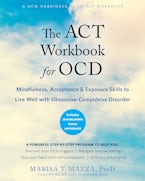By Marisa T. Mazza, PsyD, author of The ACT Workbook for OCD
Tips on Practicing Acceptance-Based Exposures:
Oftentimes the aim of traditional exposure and response prevention (ERP) is to eradicate obsessive-compulsive disorder (OCD). But for many people, obsessions and anxiety come back no matter how often they do exposures—leaving them disappointed, angry, and ashamed. The recommendation? Acceptance-based ERP, which teaches us how to get comfortable with having all types of uncertainties, obsessions, and anxieties—rather than trying to eradicate them.
Acceptance-based ERP is about learning how to have uncomfortable thoughts, feelings, and sensations while living purposefully. This means connecting with your difficult thoughts, feelings, and sensations while doing exposures. The aim is to get good at not knowing when or how we will fail, get good at not knowing if something bad will happen—and living our life anyway. To start, we welcome these experiences in order to practice having them, so that when they show up, we don’t necessarily get thrown off our game.
Here’s how to connect during your exposure practice:
1) Slow down. When we are rushing around, it’s nearly impossible to pay attention to what’s happening inside of us. This is true in both our day-to-day activities, and in our exposures. Try doing your exposures more slowly to make room for your experiences to show up.
2) Notice your practice. Once you slow down, turn your attention to your thoughts, feelings, and what is happening around you. Notice what shows up internally before, during, and after you engage in compulsions, as well as when you choose not to engage in compulsions. Notice what it feels like to spend your time and energy focused on the OCD. Notice what it’s like to spend your time focused on growing, learning, and living. While it may not always feel like a choice, you choose to entertain the obsessions, or to notice them and refocus on what matters to you.
3) Start with what you are most willing to do. Set yourself up for success by deciding which obsessions and feelings you can embrace while not engaging in avoidance or compulsions. What is something you really miss in your life? What are you most motivated to work on? Start there, then slowly move on to more challenging triggers.
4) Befriend difficult emotions. Our minds, and sometimes society, tell us that feeling anxious or sad is bad. But everyone feels sad and anxious at times, and no one has ever died from these feelings! The reality is that some emotions are challenging, and we are capable of having them. When you notice a difficult emotion show up, try embracing the emotion by identifying where it is in your body (chest, stomach, throat) and what is it feels like (tightness, heaviness, pressure). Notice what happens when you allow yourself to feel the sensation without trying to change it in any way. See what happens when you welcome it in. After a period of feeling the sensation, ask yourself, What might this emotion be trying to remind me of that is important to me?
5) Work with your mind. The mind is a very savvy machine. On one hand, you don’t want to ignore thoughts; on the other, you don’t want to take them too seriously either. Bottom line: Some thoughts are more helpful than others in moving you closer to being present in your life. When a thought shows up, ask yourself, Will focusing on this thought help me be present and get me closer to the life I want to live? If the answer is yes, then keep on focusing on it. If the answer is no, then you may want to try unhooking or detaching from the thought by using one of the following exercises:
- During exposures or in your day-to-day life, you can say, “I’m noticing my minding is telling me that…” or “I notice I am having the obsession that…”
- Picture what your mind would look like and sound like if it were a character. Then envision it telling you your thoughts.
- Try singing the thought to the tune of your favorite song.
- Picture your thoughts on a huge billboard.
Thanks to an abundance of research, we now know that trying to control or escape our experiences doesn’t work. So how you do exposures is just as important as doing exposures. Try slowing down, noticing your experiences, and getting curious about what shows up. Be kind to yourself by starting out with what you are most willing to do. Commit to getting good at feeling uncomfortable and living with uncertainty—because life gives us a ton of challenging experiences, and only by sitting with our discomfort can we learn that we are truly capable.
Marisa T. Mazza, PsyD, is a clinical psychologist, and founder of choicetherapy psychological services, inc. For fifteen years, she has utilized evidence-based treatments to help people with obsessive-compulsive disorder (OCD) and anxiety. She created and operates an individual therapy practice and intensive outpatient program in San Francisco, CA. Mazza and her team integrate evidence-based treatments—such as acceptance and commitment therapy (ACT), exposure response and prevention (ERP), and compassion-focused therapy (CFT)—to assist adults and adolescents in changing their relationship with obsessions and compulsions in order to live vitally. She is on the board of OCD SF Bay Area (the International OCD Foundation’s local affiliate), president of the San Francisco Bay Area Chapter of the Association for Contextual Behavioral Science, and faculty in the department of education at the University of San Francisco.



 Part 2: What to Do When a Client Is Participating in Self-Judgment?
Part 2: What to Do When a Client Is Participating in Self-Judgment?